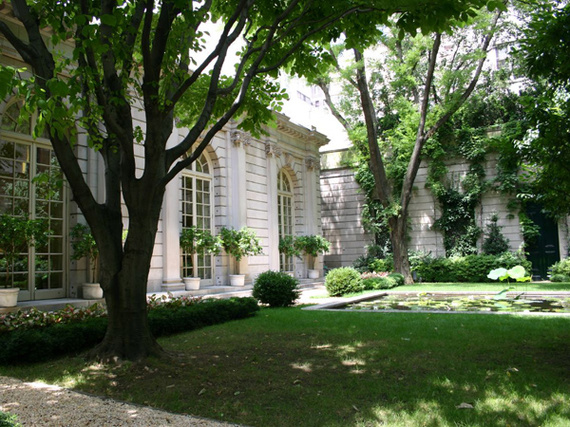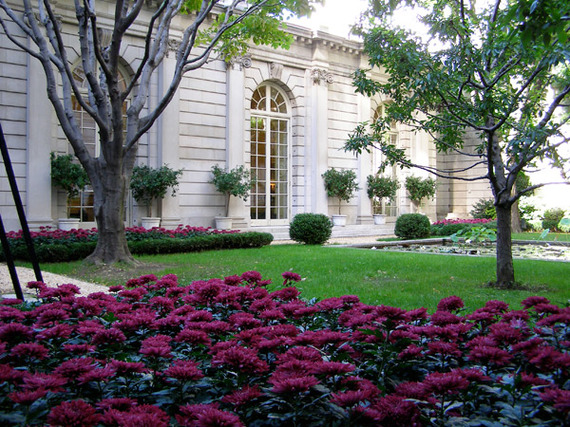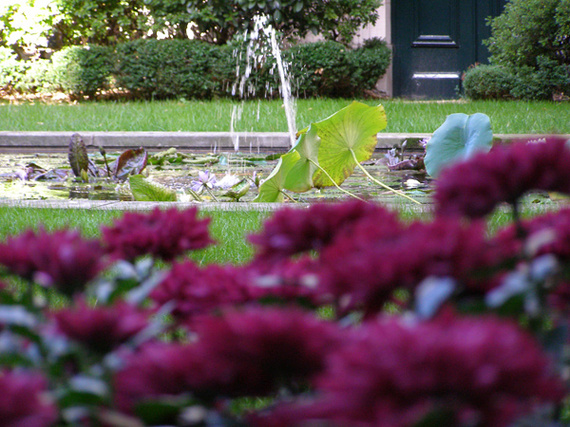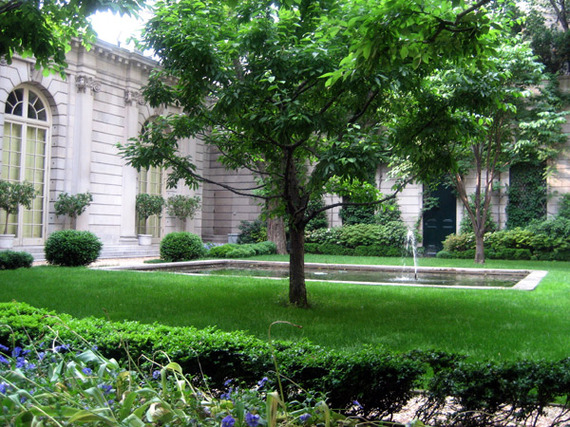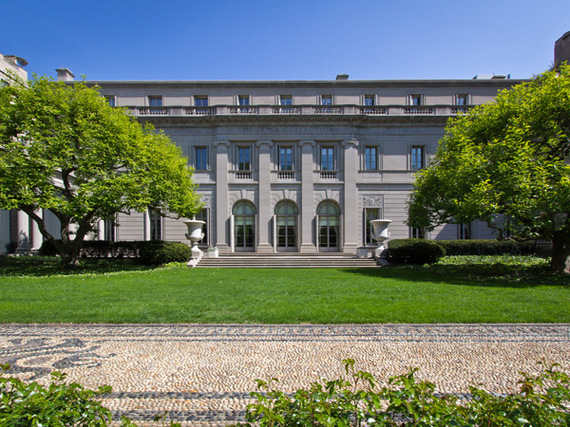The announcement that the Frick Collection on New York's Upper East Side plans to build an addition has generated some buzz and concern - and if implemented, it would forever destroy an important part of the collection - an exquisite garden by the world famous British landscape architect Russell Page (1906-85).
Page designed gardens in Europe, the Middle East, and North and South America for clients including William and Babe Paley (at their Long Island estate, Kiluna Farm), Anne Bass (to complement her Modernist Paul Rudolph-designed home in Fort Worth, TX), the National Arboretum in Washington, DC, Longleat House in England, Giardini della Landriana in Italy and the Donald M. Kendall Sculpture Gardens at PepsiCo in Purchase, NY, among others.
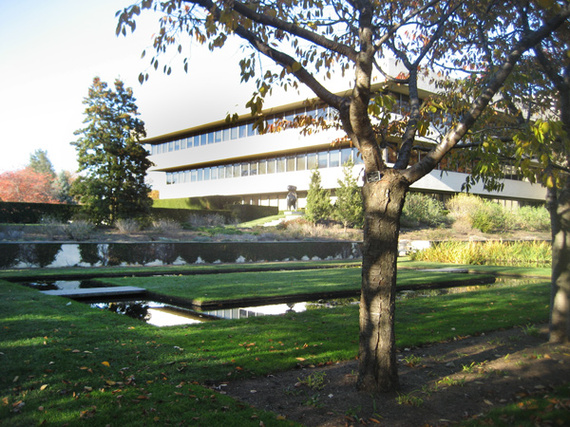 Donald M. Kendall Sculpture Garden at PepsiCo. Photograph by Brian Bailey.
Donald M. Kendall Sculpture Garden at PepsiCo. Photograph by Brian Bailey.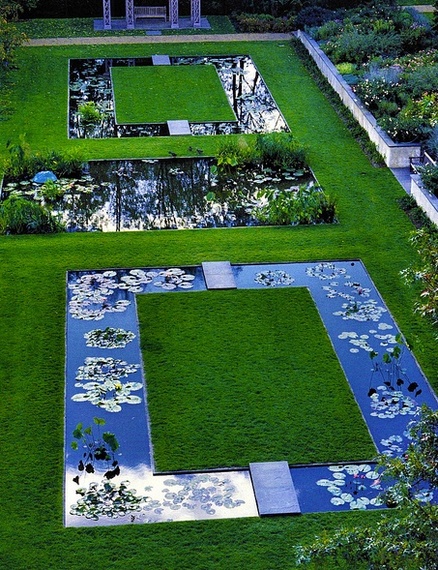 Donald M. Kendall Sculpture Garden at PepsiCo. Photograph from The Gardens of Russell Page.
Donald M. Kendall Sculpture Garden at PepsiCo. Photograph from The Gardens of Russell Page.
According to Nancy Berner and Susan Lowry's Garden Guide: New York City (W. W. Norton & Company, 2010): The Frick "is one of a number of public projects the English designer undertook at the end of his life, hoping to preserve his reputation for posterity."
Yet, in all of the reporting (save that of Julia Halperin at the Art Newspaper and CultureGrrl's Lee Rosenbaum), mention of Page has been absent and the garden has been deemed insignificant, or at best, "a discreet garden and a splashing fountain with lily pads." The New York Times' coverage is symptomatic: the addition would be built on "space currently occupied by a gated garden that is not open to the public" - language that dovetails with the Frick's press release - "a gated side garden ... which has always been inaccessible to the public." In actuality, though deliberately designed for viewing, a quick Google search yields scores of photographs of people at events held in the Page garden. Nevertheless, the site is depicted as under utilized, or worse - in an era when just about everything is monetized - under performing.
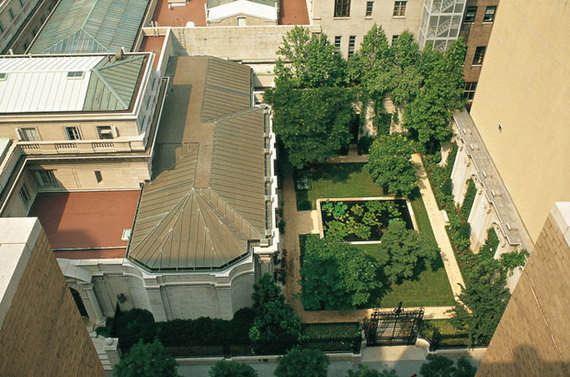 Aerial view of the Russell Page garden at the Frick Collection. Photograph from The Gardens of Russell Page.
Aerial view of the Russell Page garden at the Frick Collection. Photograph from The Gardens of Russell Page.
Now, there is no dispute that the former home of industrialist Henry Clay Frick and its remarkable collection including artwork by Bellini, Vermeer, Rembrandt and Watteau among them, is a jewel among the city's cultural institutions. In fact, "From the very beginning," says the Frick's Web site, "the house [completed exactly one century ago] was intended to become a museum following the deaths of the founder and his wife." While some museum patrons confront battalions of tourists at the Metropolitan Museum of Art and the Museum of Modern Art, "in the know" New Yorkers and visitors find peace and transcendence at this oasis made possible by a great act of civic patronage.
The Frick's press announcement states that the "new addition, which will provide the institution with a net gain of 42,000 square feet, will house more gallery space, an expanded entrance hall, additional space for the Frick's world-renowned art reference library, new classrooms, a 220-seat auditorium, expanded administrative space, and updated conservation laboratories, as well as a rooftop garden terrace for museum visitors." And, of the proposed construction zone: "Originally the site of three unrelated townhouses, the property was acquired by the Frick over a period of decades beginning in the 1940s with an eye towards expanding the building to better serve the public. But, due to a lack of funds, in 1977, the Frick was only able to build a structure with a small reception hall, coat check, and shop on the ground-floor level, and two small rooms in the basement, with the gated private garden occupying the remaining space." But is that the whole story?
According to Gabrielle van Zuylen and Marina Schinz, authors of The Gardens of Russell Page (Frances Lincoln, 2008): "In 1972, when the trustees of the Frick decided to tear down the adjacent Widener house to build a new gallery wing, they were met by neighborhood protests. To calm the atmosphere they agreed to create a temporary courtyard garden in its place for ten or fifteen years, before going ahead with the addition. The garden is now permanent."
So, why has landscape architect Russell Page been ignored and his creation deemed irrelevant? Did no one think to ask who designed this garden and is it important?
Frick director Ian Wardropper, in a June 19, 2014, letter to the editor of the New York Times, sought to assuage the concerns expressed in an earlier Op-Ed. He stated: "We care deeply about preserving our glorious building and extraordinary collection, while providing an enriching experience to all who love art. That's why we've proposed a plan that will not change the way visitors experience the historic house and masterpieces."
That is, except for the Page garden.
The renowned American landscape architect and recent presidential Medal of Art recipient Laurie Olin wrote me on June 11, 2014, to say he was "outraged" by "this Vandalism." Paula Deitz, editor of The Hudson Review, in a still unpublished letter to the editor of the New York Times, wrote that Page, "working with the Frick's then director, Everett Fahy, created the enclosed terrace on East 70th Street to evoke the charm of catching a glimpse of a private French garden compatible with the Neoclassical architecture of the Frick mansion. With a rectangular lily pond stretching across a central lawn along with low green hedges, planting beds, and trees rotated into position for the best angle from the street, it has become a treasured visual urban amenity." She went on to compare it to "viewing a masterwork of landscape painting."
The design for this relatively small space is inventive. As Deitz wrote in her essay "'Make the Land Work for You': Russell Page in America" (from Of Gardens: Selected Essays, University of Pennsylvania Press, 2011): "Because Page understood that people cannot judge distances over water, the rectangular lily pond that stretches across the central lawn creates the illusion of great depth in shallow space." Galen Lee, the Frick's Horticulturalist and Special Events Designer, describes the Page garden as "soft and intimate. In the words of its designer this garden is to be viewed -- from the street or through the arched windows of the Reception Hall -- like an Impressionist painting." Or as Deitz puts it, "Nothing is more tantalizing or inducive to fantasy than a beautifully trimmed garden with a refreshing fountain in an enclosure that no one may enter."
Along with the Page garden, the museum has its elegant Fifth Avenue garden from 1935 by landscape architect Frederick Law Olmsted, Jr. An image of the garden accompanies the Frick's mission statement, which reads in part: "To preserve and display for the public the Collection, and to augment its holdings in fields established by Henry Clay Frick, reflecting the uncompromising levels of quality that he embraced, and maintaining the historic tranquility of Mr. Frick's house." Unfortunately, the only design credit given is to the Board of Trustees who in 1939 are said to have selected three magnolias for the garden.
The reality is that landscapes are inherently ephemeral and too often viewed as places to "put stuff." It's all the more unfortunate when museums - our cultural stewards, protectors and promoters - fall short. The recent addition to the Kimbell Art Museum in Fort Worth, TX came at the expense of its landscape by Harriet Pattison and George E. Patton, and a garden at the Columbus Museum of Art, also designed by Page, was lost to that museum's recent expansion.
Frick officials have the opportunity to acknowledge the importance of this garden and honor the artist who created it, landscape architect Russell Page. They should embrace it as a valued and unique part of its collection, and find a solution that addresses their programmatic needs and protects this important work of art.
As the Frick's horticulturalist notes: "Page's garden is designed to slow, or stop, a busy New Yorker, to pause for a moment -- a respite from the city." It's an oasis everyone can enjoy.
Postscript: My follow-up article of August 26, 2014 published a 1977 Frick Collection press release that revealed that the museum's Russell Page-designed garden was created to be a "permanent garden" ("That 'Temporary' Frick Garden -- It Was Created to Be Permanent"). In addition, the Page garden was included among the nationally significant threatened and at-risk sites on Landslide 2014: Art and the Landscape.

